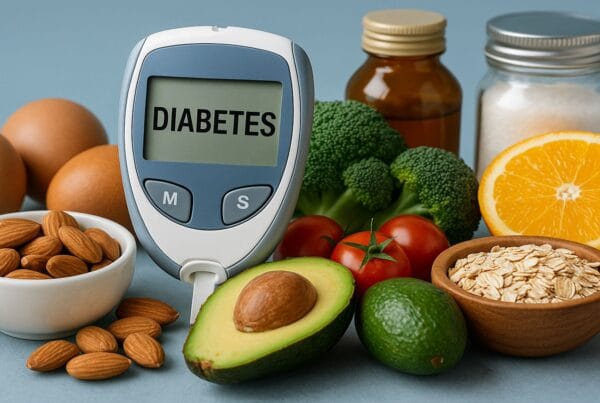Diabetes mellitus
INTRODUCTION: The Sweet Days Are Over
Sugar seems like an innocent companion in everyday life. We sprinkle it into tea, bake it into cakes, and let it make kids dizzy with joy. But when blood sugar levels spiral out of control, it can mercilessly disrupt the body’s systems. Diabetes doesn’t appear overnight – it grows silently, fueled by habits, stress, and a lack of movement. Eventually, it arrives with consequences: fatigue, thirst, brain fog, and a long list of medical tests.
But this is not a story of resignation. It’s a guide to consciously changing your lifestyle, understanding the mechanisms behind the disease, and managing health daily. Yes, there will be medical facts, practical advice, some curiosities, and a pinch of humor. Because even with diabetes, life can still be delicious.
What Exactly Is Diabetes?
Imagine your body as a well-managed city. Glucose is the fuel powering every cell – from neurons in the brain to muscles in the legs. To deliver this fuel where it’s needed, insulin is required – a hormone produced by the pancreas that acts like a key opening the doors to the cells.
In diabetes, this mechanism breaks down. Either the pancreas doesn’t produce insulin (type 1 diabetes), or the body stops responding to it (type 2 diabetes). The result? Glucose gets trapped in the blood – instead of providing energy, it starts to cause harm.
Over time, high glucose levels damage blood vessels, nerves, and organs. That’s why untreated diabetes isn’t just a “sugar problem,” but a real threat to the heart, eyes, kidneys, and legs.
What Are the Types of Diabetes?
Type 1 Diabetes
This is an autoimmune disease – the body mistakenly attacks its own beta cells in the pancreas, which produce insulin. It usually appears in children and teenagers, though not exclusively. It requires daily insulin injections and careful glucose monitoring. Symptoms often appear suddenly.
Type 2 Diabetes
This is the most common type (about 90% of cases). Initially, the pancreas produces insulin, but the body’s cells become “deaf” to it – this is known as insulin resistance. The disease develops over many years and can be sneaky, showing no symptoms for a long time. It mostly affects adults, especially those who are overweight and physically inactive.
Gestational Diabetes
Occurs only during pregnancy and usually disappears after birth. It results from hormonal changes that make insulin less effective. Though temporary, it increases the risk of developing type 2 diabetes later – for both mother and child.
Other, Less Common Types:
- Monogenic diabetes (e.g., MODY, neonatal diabetes): caused by single gene mutations
- Secondary diabetes: due to other diseases (e.g., pancreatitis, Cushing’s syndrome) or medications (e.g., steroids)
In all forms, the common thread is high blood sugar and its impact on the body. But the causes, symptoms, and treatments can differ greatly – identifying the type of diabetes is the first key step to effective treatment.
Rare Forms of Diabetes – The Ones Nobody Talks About
LADA – Adult-Onset Diabetes That Pretends to Be Type 2
This is an autoimmune form like type 1 but develops slowly and usually affects adults. Often misdiagnosed as type 2 – and then diet and tablets don’t help. It requires insulin earlier.
MODY – The Inherited Diabetes Passed Like a Family Heirloom
A rare, genetic form of diabetes. Usually appears in young people but is not autoimmune. MODY includes several subtypes – some can be treated without insulin, others cannot. Genetic testing is recommended if “everyone has diabetes in the family, but no one is overweight.”
In every case, high blood sugar and its damage to the body are central. But knowing the cause is crucial for choosing the right treatment.
What Are the Most Common Symptoms of Diabetes That Are Easy to Miss?
Often confused with fatigue, stress, or… aging. Symptoms include:
- increased thirst
- frequent urination, especially at night
- uncontrollable appetite (and weight loss despite eating)
- drowsiness after meals
- blurred vision
- itchy skin and intimate infections
- slow wound healing
Untreated diabetes leads to complications in the eyes, kidneys, nervous system, and circulation. That’s why early detection is essential.
What Tests Should You Get to Detect Diabetes (or Its Early Stages)?
Fasting glucose isn’t enough. Full diagnosis includes:
- fasting and post-meal glucose
- oral glucose tolerance test (OGTT)
- insulin levels and HOMA-IR index
- glycated hemoglobin (HbA1c)
- lipid profile
- C-peptide (especially to differentiate types)
- urine test (sugar, protein, ketones)
Also monitor blood pressure, weight, waist circumference, and inflammation markers. Diabetes likes to work silently.
What Should a Diabetic Diet Look Like – What to Eat, What to Avoid?
Rule number one: goodbye to sugary rolls and juice with breakfast. But don’t worry – the world doesn’t end, just your plate changes.
Recommended foods:
- vegetables (especially leafy greens, broccoli, pumpkin, zucchini)
- whole grains (buckwheat, quinoa, amaranth)
- legumes
- nuts, seeds
- healthy fats (olive oil, avocado, fish)
- berries (blueberries, raspberries, blackcurrant)
Foods to avoid or limit:
- sugar (white, cane, coconut – no difference)
- white bread and rice
- sweet drinks
- fast food
- processed food
The diet should have a low glycemic index (GI), be high in fiber and antioxidants. Best eaten in 4–5 small meals a day.
Can Type 2 Diabetes Be Reversed?
Some people achieve remission – blood sugar levels normalize without medication. Key steps:
- losing excess weight
- changing diet
- regular physical activity
- reducing stress
- proper sleep and circadian rhythm
Note: remission isn’t a cure! The disease lingers and needs continued monitoring. But the good news? Many live medication-free and full of life.
How to Manage Diabetes Daily Without Losing Your Mind?
Planning, patience, and… a bit of humor. Useful tools:
- regular glucose monitoring (traditionally or with CGM)
- food and activity journal
- planned shopping and meals
- learning to read labels
- support from loved ones or groups (really works!)
Most important: don’t see diabetes as a punishment – see it as a wake-up call to take care of yourself.
Does Sleep and the Circadian Rhythm Affect Blood Sugar?
Absolutely. Lack of sleep = more cortisol, more sugar cravings, and worse glucose control.
What helps:
- 7–9 hours of sleep daily
- avoiding screens before bed
- dinner 2–3 hours before sleep
- consistent schedule – sleep and wake at the same times
Sleep isn’t a luxury – it’s an over-the-counter diabetes remedy.
Does a Plant-Based Diet Help With Diabetes?
Yes – but only if it doesn’t rely on fries and cookies labeled “vegan.”
A well-balanced plant-based diet:
- reduces insulin resistance
- provides fiber and phytonutrients
- has low GI
- lowers inflammation
Avoid processed products and eat the rainbow – the more colorful your plate, the better for your pancreas.
Can You Exercise With Diabetes?
Not only can you – you must! Physical activity is a natural “sugar burner.”
Good options include:
- walking, Nordic walking
- yoga, Pilates
- swimming, cycling
- strength training
A 15-minute walk after a meal works wonders. But don’t forget to check your glucose before and after!
Is Diabetes a Life Sentence? How to Reclaim Joy?
No – it’s a message from your body. If you treat it as a partner (not an enemy), you can go far together.
What helps:
- accepting the diagnosis
- education – knowledge = control
- celebrating small wins
- self-compassion
A sweet life doesn’t need sugar.
How Does Stress Affect Glucose Levels? Do We Really Need to “Relax”?
Stress increases cortisol, which increases sugar. Chronic stress is a glucose enemy.
What helps:
- meditation, breathing, relaxation
- time in nature
- laughter! Yes, it really helps
You may not change the world – but you can change how you respond to it.
Do Herbs and Natural Supplements Really Help?
They don’t replace treatment, but they can support it:
- white mulberry – blocks sugar absorption
- berberine – works like metformin
- fenugreek – improves insulin sensitivity
- Ceylon cinnamon – helps regulate glucose
Always consult your doctor before supplementation. Nature is wise, but powerful.
Can Children Have Diabetes? What Then?
Yes. And more often than we’d like to admit. Type 1 diabetes is the form that most frequently “favors” children and teenagers. It doesn’t ask about age, doesn’t give a warning—it just appears. Suddenly, instead of carrying only a backpack, your child might now carry a glucose meter, insulin pen, and a brand new daily routine.
Sounds serious? It is. But it’s not a tragedy.
Children with diabetes can live life to the fullest — they can run, ride bikes, go diving, enjoy ice cream (yes, really!), take exams, and dream of becoming pilots, doctors, or bakers. They just need to learn how their body works, how to manage their energy, and how to recognize the body’s signals. And believe it or not — they usually master it faster than most adults.
Most common symptoms of diabetes in children:
- Sudden and intense thirst, that doesn’t go away (your child may drink liters of water a day)
- Frequent urination, including at night (even if bedwetting was never an issue before)
- Noticeable fatigue, sleepiness, and lack of energy
- Weight loss, despite a normal or increased appetite
- Irritability, trouble concentrating, mood swings
- Recurring infections (e.g., fungal or skin infections)
- Sweet-smelling breath, resembling acetone
And the parents? They become the crisis response team, the support squad, label-reading specialists, and lunchbox champions. Over time, tears turn into routine, and routine into strength. Suddenly, this “scary diabetes” becomes part of a normal life—just one with a little more alertness and, surprisingly, a new level of family closeness.
What matters most? That we don’t run out of understanding, warmth, and… the occasional sugar-free chocolate (but only with insulin at the ready 😉).
🔧 Life to Repair? You’ve Got All the Tools
Diabetes isn’t a punishment for dietary sins — it’s your body’s way of saying: it’s time to take control. You don’t need a revolution or a lab in your kitchen. You need small daily decisions: less sugar, more movement, better sleep, and greater awareness. And you already have everything you need. Don’t fight the disease – cooperate with your body. It knows what it’s doing. Now it’s your turn to know too.Diabetes mellitus
INTRODUCTION: The Sweet Days Are Over
Sugar seems like an innocent companion in everyday life. We sprinkle it into tea, bake it into cakes, and let it make kids dizzy with joy. But when blood sugar levels spiral out of control, it can mercilessly disrupt the body’s systems. Diabetes doesn’t appear overnight – it grows silently, fueled by habits, stress, and a lack of movement. Eventually, it arrives with consequences: fatigue, thirst, brain fog, and a long list of medical tests.
But this is not a story of resignation. It’s a guide to consciously changing your lifestyle, understanding the mechanisms behind the disease, and managing health daily. Yes, there will be medical facts, practical advice, some curiosities, and a pinch of humor. Because even with diabetes, life can still be delicious.
What Exactly Is Diabetes?
Imagine your body as a well-managed city. Glucose is the fuel powering every cell – from neurons in the brain to muscles in the legs. To deliver this fuel where it’s needed, insulin is required – a hormone produced by the pancreas that acts like a key opening the doors to the cells.
In diabetes, this mechanism breaks down. Either the pancreas doesn’t produce insulin (type 1 diabetes), or the body stops responding to it (type 2 diabetes). The result? Glucose gets trapped in the blood – instead of providing energy, it starts to cause harm.
Over time, high glucose levels damage blood vessels, nerves, and organs. That’s why untreated diabetes isn’t just a “sugar problem,” but a real threat to the heart, eyes, kidneys, and legs.
What Are the Types of Diabetes?
Type 1 Diabetes
This is an autoimmune disease – the body mistakenly attacks its own beta cells in the pancreas, which produce insulin. It usually appears in children and teenagers, though not exclusively. It requires daily insulin injections and careful glucose monitoring. Symptoms often appear suddenly.
Type 2 Diabetes
This is the most common type (about 90% of cases). Initially, the pancreas produces insulin, but the body’s cells become “deaf” to it – this is known as insulin resistance. The disease develops over many years and can be sneaky, showing no symptoms for a long time. It mostly affects adults, especially those who are overweight and physically inactive.
Gestational Diabetes
Occurs only during pregnancy and usually disappears after birth. It results from hormonal changes that make insulin less effective. Though temporary, it increases the risk of developing type 2 diabetes later – for both mother and child.
Other, Less Common Types:
- Monogenic diabetes (e.g., MODY, neonatal diabetes): caused by single gene mutations
- Secondary diabetes: due to other diseases (e.g., pancreatitis, Cushing’s syndrome) or medications (e.g., steroids)
In all forms, the common thread is high blood sugar and its impact on the body. But the causes, symptoms, and treatments can differ greatly – identifying the type of diabetes is the first key step to effective treatment.
Rare Forms of Diabetes – The Ones Nobody Talks About
LADA – Adult-Onset Diabetes That Pretends to Be Type 2
This is an autoimmune form like type 1 but develops slowly and usually affects adults. Often misdiagnosed as type 2 – and then diet and tablets don’t help. It requires insulin earlier.
MODY – The Inherited Diabetes Passed Like a Family Heirloom
A rare, genetic form of diabetes. Usually appears in young people but is not autoimmune. MODY includes several subtypes – some can be treated without insulin, others cannot. Genetic testing is recommended if “everyone has diabetes in the family, but no one is overweight.”
In every case, high blood sugar and its damage to the body are central. But knowing the cause is crucial for choosing the right treatment.
What Are the Most Common Symptoms of Diabetes That Are Easy to Miss?
Often confused with fatigue, stress, or… aging. Symptoms include:
- increased thirst
- frequent urination, especially at night
- uncontrollable appetite (and weight loss despite eating)
- drowsiness after meals
- blurred vision
- itchy skin and intimate infections
- slow wound healing
Untreated diabetes leads to complications in the eyes, kidneys, nervous system, and circulation. That’s why early detection is essential.
What Tests Should You Get to Detect Diabetes (or Its Early Stages)?
Fasting glucose isn’t enough. Full diagnosis includes:
- fasting and post-meal glucose
- oral glucose tolerance test (OGTT)
- insulin levels and HOMA-IR index
- glycated hemoglobin (HbA1c)
- lipid profile
- C-peptide (especially to differentiate types)
- urine test (sugar, protein, ketones)
Also monitor blood pressure, weight, waist circumference, and inflammation markers. Diabetes likes to work silently.
What Should a Diabetic Diet Look Like – What to Eat, What to Avoid?
Rule number one: goodbye to sugary rolls and juice with breakfast. But don’t worry – the world doesn’t end, just your plate changes.
Recommended foods:
- vegetables (especially leafy greens, broccoli, pumpkin, zucchini)
- whole grains (buckwheat, quinoa, amaranth)
- legumes
- nuts, seeds
- healthy fats (olive oil, avocado, fish)
- berries (blueberries, raspberries, blackcurrant)
Foods to avoid or limit:
- sugar (white, cane, coconut – no difference)
- white bread and rice
- sweet drinks
- fast food
- processed food
The diet should have a low glycemic index (GI), be high in fiber and antioxidants. Best eaten in 4–5 small meals a day.
Can Type 2 Diabetes Be Reversed?
Some people achieve remission – blood sugar levels normalize without medication. Key steps:
- losing excess weight
- changing diet
- regular physical activity
- reducing stress
- proper sleep and circadian rhythm
Note: remission isn’t a cure! The disease lingers and needs continued monitoring. But the good news? Many live medication-free and full of life.
How to Manage Diabetes Daily Without Losing Your Mind?
Planning, patience, and… a bit of humor. Useful tools:
- regular glucose monitoring (traditionally or with CGM)
- food and activity journal
- planned shopping and meals
- learning to read labels
- support from loved ones or groups (really works!)
Most important: don’t see diabetes as a punishment – see it as a wake-up call to take care of yourself.
Does Sleep and the Circadian Rhythm Affect Blood Sugar?
Absolutely. Lack of sleep = more cortisol, more sugar cravings, and worse glucose control.
What helps:
- 7–9 hours of sleep daily
- avoiding screens before bed
- dinner 2–3 hours before sleep
- consistent schedule – sleep and wake at the same times
Sleep isn’t a luxury – it’s an over-the-counter diabetes remedy.
Does a Plant-Based Diet Help With Diabetes?
Yes – but only if it doesn’t rely on fries and cookies labeled “vegan.”
A well-balanced plant-based diet:
- reduces insulin resistance
- provides fiber and phytonutrients
- has low GI
- lowers inflammation
Avoid processed products and eat the rainbow – the more colorful your plate, the better for your pancreas.
Can You Exercise With Diabetes?
Not only can you – you must! Physical activity is a natural “sugar burner.”
Good options include:
- walking, Nordic walking
- yoga, Pilates
- swimming, cycling
- strength training
A 15-minute walk after a meal works wonders. But don’t forget to check your glucose before and after!
Is Diabetes a Life Sentence? How to Reclaim Joy?
No – it’s a message from your body. If you treat it as a partner (not an enemy), you can go far together.
What helps:
- accepting the diagnosis
- education – knowledge = control
- celebrating small wins
- self-compassion
A sweet life doesn’t need sugar.
How Does Stress Affect Glucose Levels? Do We Really Need to “Relax”?
Stress increases cortisol, which increases sugar. Chronic stress is a glucose enemy.
What helps:
- meditation, breathing, relaxation
- time in nature
- laughter! Yes, it really helps
You may not change the world – but you can change how you respond to it.
Do Herbs and Natural Supplements Really Help?
They don’t replace treatment, but they can support it:
- white mulberry – blocks sugar absorption
- berberine – works like metformin
- fenugreek – improves insulin sensitivity
- Ceylon cinnamon – helps regulate glucose
Always consult your doctor before supplementation. Nature is wise, but powerful.
Can Children Have Diabetes? What Then?
Yes. And more often than we’d like to admit. Type 1 diabetes is the form that most frequently “favors” children and teenagers. It doesn’t ask about age, doesn’t give a warning—it just appears. Suddenly, instead of carrying only a backpack, your child might now carry a glucose meter, insulin pen, and a brand new daily routine.
Sounds serious? It is. But it’s not a tragedy.
Children with diabetes can live life to the fullest — they can run, ride bikes, go diving, enjoy ice cream (yes, really!), take exams, and dream of becoming pilots, doctors, or bakers. They just need to learn how their body works, how to manage their energy, and how to recognize the body’s signals. And believe it or not — they usually master it faster than most adults.
Most common symptoms of diabetes in children:
- Sudden and intense thirst, that doesn’t go away (your child may drink liters of water a day)
- Frequent urination, including at night (even if bedwetting was never an issue before)
- Noticeable fatigue, sleepiness, and lack of energy
- Weight loss, despite a normal or increased appetite
- Irritability, trouble concentrating, mood swings
- Recurring infections (e.g., fungal or skin infections)
- Sweet-smelling breath, resembling acetone
And the parents? They become the crisis response team, the support squad, label-reading specialists, and lunchbox champions. Over time, tears turn into routine, and routine into strength. Suddenly, this “scary diabetes” becomes part of a normal life—just one with a little more alertness and, surprisingly, a new level of family closeness.
What matters most? That we don’t run out of understanding, warmth, and… the occasional sugar-free chocolate (but only with insulin at the ready 😉).
🔧 Life to Repair? You’ve Got All the Tools
Diabetes isn’t a punishment for dietary sins — it’s your body’s way of saying: it’s time to take control. You don’t need a revolution or a lab in your kitchen. You need small daily decisions: less sugar, more movement, better sleep, and greater awareness. And you already have everything you need. Don’t fight the disease – cooperate with your body. It knows what it’s doing. Now it’s your turn to know too.






















